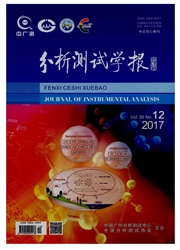

 中文摘要:
中文摘要:
提出一种核偏最小二乘(KPLS)特征提取耦合支持向量回归机(SVR)的新方法,用于实现气测录井中傅立叶变换红外(FTIR)光谱法对甲烷、乙烷、丙烷、异丁烷、正丁烷、异戊烷以及正戊烷7种组分混合气体的定量分析。采用KPLS方法对光谱数据进行特征提取,将得到的特征组分作为SVR的输入建立7组分气体的定量分析模型。对相同混合气体进行定量分析,结果显示,采用KPLS特征提取后,SVR模型对7种组分气体的预测均方根误差(RMSEP)分别为0.116、0.079、0.104、0.092、0.108、0.029和0.016,均小于线性偏最小二乘法(LPLS)、LPLS-SVR、KPLSR以及SVR模型的RMSEP。结果表明,KPLS-SVR法可以更好地提取隐含在混合气体FTIR光谱数据与其组分浓度之间的非线性特征,并有效地消除光谱数据噪声,大幅度降低数据维数,是一种有效的气测录井烷烃混合气体定量分析方法。
 英文摘要:
英文摘要:
A new method was presented for quantitative analysis of alkane gaseous mixtures composed of methane, ethane, propane, isobutane, n-butane, isopentane, and n-pentane during oil logging by kernel partial least square (KPLS) combination with support vector regression machine (SVR). The optimal latent variables of FTIR spectrum of seven-component alkane gaseous mixtures were firstly extracted by KPLS to substitute the original spectral data. A quantitative analysis model was established by using the extracted latent variables as input data of SVR model, and the concentrations of every component gases as output data of SVR model. The root mean square error of prediction ( RM- SEP) was used as evaluation criterion to evaluate the prediction ability of KPLS - SVR model, and the analysis results of identical unknown concentration seven-component gases mixtures by KPLS - SVR, LPLS, KPLSR, LPLS- SVR and SVR model were compared. The results showed that the RMSEP of KPLS- SVR model for seven components were 0. 116, 0. 079, 0. 104, 0. 092, 0. 108, 0. 029 and 0. 016, respectively, less than the RMSEP of other models. The result indicated that KPLS approach could effectively extract the connotative features between the spectra and component concentration, eliminate noise of FTIR spectral data, and reduce the dimension of spectral matrix. Therefore, KPLS - SVR is a very effective method for quantitative analysis of alkane gas mixture during gas logging.
 同期刊论文项目
同期刊论文项目
 同项目期刊论文
同项目期刊论文
 期刊信息
期刊信息
